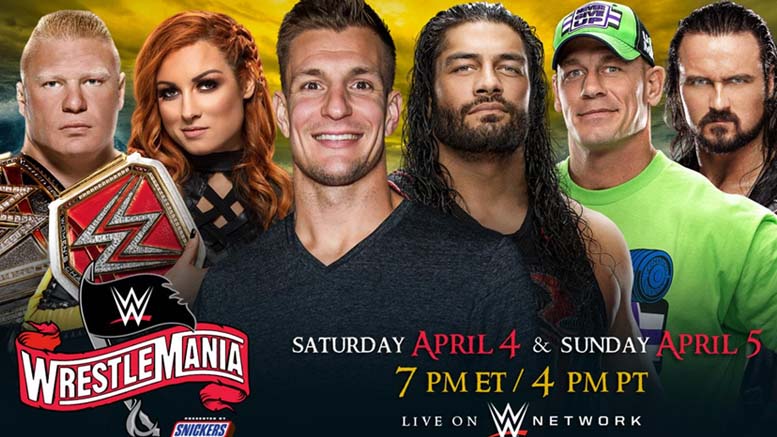What if the WWE held WrestleMania and nobody came?
It sounds like a bizarro scenario, or a wacky joke, that one couldn’t fathom considering the mass appeal of professional wrestling, or as World Wrestling Entertainment would self-describe it, “sports entertainment.”
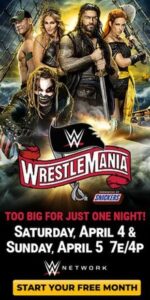 Due to the coronavirus pandemic, that improbability has now effectively struck WWE Chairman and CEO Vince McMahon squarely against his hardened, chiseled chin for his event that will be “held” this weekend.
Due to the coronavirus pandemic, that improbability has now effectively struck WWE Chairman and CEO Vince McMahon squarely against his hardened, chiseled chin for his event that will be “held” this weekend.
It originally wasn’t designed that way. In early-March, the brand was full-speed ahead and heading into the 36th annual “Showcase of Immortals,” a pre-paid crowd of 47,000 would cheer rabidly at Raymond James Stadium in Tampa, Florida while the WWE Universe would watch globally via digital platforms.
Or that was the plan. We all know how the month would ultimately progress.
With COVID-19 affecting spring sports, one would get the impression that the WWE brain trust would simply move its multi-million dollar presentation to later in the calendar year. That seemed to be the assumption since other sports were either postponing their respective starts or pushing high profile events, such as the Kentucky Derby and the Indianapolis 500, to the fall.
However, we underestimated how stubborn “Vinnie Mac” could be.
Instead of calmly re-scheduling the event to a later date, WrestleMania now takes place at the WWE Performance Center (their self-financed developmental operation) in Orlando, Florida and at other closed-set locations. The annual April super show, which traditionally consumed a rough average of five hours on a Sunday night, will now be separated into two pre-taped, half-events this weekend.
That’s right. When you read this, all of the matches have already been recorded and are currently in the post-production process for Saturday and Sunday playback.
Because of current restrictions on the amount of people that can attend public events, the attendance can be counted on one hand each night. Actually, you don’t need a hand at all.
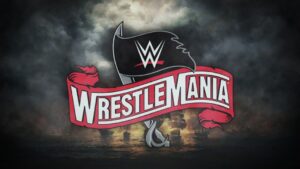 The live attendance at this year’s twin nights of WrestleMania will be an all-time low of zero.
The live attendance at this year’s twin nights of WrestleMania will be an all-time low of zero.
One shouldn’t try to fudge numbers that includes wrestlers, referees and video/audio technicians. The attendance written in the history books will be an Andre the Giant-sized goose egg.
It’s pretty sad, considering the line-up’s potential. Originally highlighting the event were championship defenses from Brock Lesnar and Bill Goldberg, appearances from Randy Orton, Drew McIntyre, AJ Styles and Charlotte Flair and in-ring returns by the Undertaker, Edge and John Cena after sabbaticals.
Altogether, there were thirteen matches that would have drained the usual wrestling (eh..sports entertainment) junkie at a one-night, live event originally scheduled for Sunday.
These matches will still take place but will not be performed in front of the live audience originally projected. One could assume that the aforementioned 47K would also have enough comps that would push the attendance to potentially 57,000. And seeing how the WWE likes to fudge the numbers when it comes to high ticket attractions, I’m sure that they would promote that James Raymond Stadium would boast a new in-house record of 65,000 for a one-time event. They’ll include every hot dog vendor, if need be.
Why would McMahon, who has been at the helm of the currently-valued $5.7 billion squared-circle juggernaut since 1982, refuse to throw in the white towel and save face and money, and protect the safety of his contracted employees, at a time when public sporting competitions and exhibitions refuse to take place?
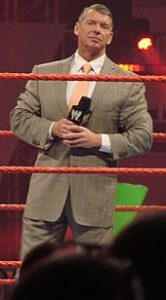 It’s because he’s stubborn. He simply refuses to say no.
It’s because he’s stubborn. He simply refuses to say no.
This has been a quality that has simultaneously defined and damned his character through time.
By marching to the beat of his own drum, McMahon broke the traditional wrestling landscape of geographical territories in the 1980’s and blossomed his family’s mostly-Northeastern business into a world-wide phenomenon, both in live event production and television distribution.
With the advent of pay-per-view, he was able to make wrestling events an additional source of massive revenue for big-ticket events such as WrestleMania.
Licensing deals put the brand on t-shirts and within toy boxes. Owning action figures with fictional characters suddenly became cool again. The “Attitude Era” brought unprecedented cable television ratings and pushed the company to becoming publicly-traded.
Not bad for entertainment whose outcomes are predetermined. This was the treasures claimed through McMahon’s hard work, tireless dedication and pretty heavy cajones.
Given all that success, the 74-year-old has also made numerous fiscal blunders. The World Bodybuilding Federation. A flopped restaurant in New York City’s Times Square. XFL Version 1.0. They all came from the same custom-made suit with a tight collar. When WWE’s titan went outside his wheelhouse, he has mostly failed.
So when the recent virus made his prized possession do the J-O-B in the Sunshine State earlier this month, safe money was that McMahon would forge ahead and move the event to a time when the mayhem subsided in order to retain the integrity of the event, maintain goodwill with both the city of Tampa and a paying audience and provide the opportunity for revenue streams in the form of ticket, merchandise and distribution sales.
Instead, McMahon ignored the situation and went on with WrestleMania as scheduled, pandemic be damned. At the risk of the brand, and physical well-being of his contracted talent, the show will limp on. But at what cost and why would one want to forge ahead?
Perhaps he didn’t want to go 0-for-2 in athletics this year. His reboot of the XFL in February was cancelled after five weeks and even though the second go-around on the gridiron was met with critical praise, as well as solid support locally for the St. Louis BattleHawks, the league as a whole nationally was experiencing the same television ratings and live audience erosion as experienced in 2001. And with eight different XFL teams, that meant dealing with a unique octet of venues. The outlook was shaky but the end result was not of their immediate control.
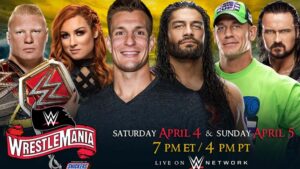 As much as it hurt for local football fanatics this season, the XFL’s early closure arguably saved it from another one-season extinction and an optimistic 2021 season, which includes possible expansion, is already scheduled.
As much as it hurt for local football fanatics this season, the XFL’s early closure arguably saved it from another one-season extinction and an optimistic 2021 season, which includes possible expansion, is already scheduled.
Wrestling (ack, sport entertainment!) is a different beast incarnate altogether. Even if one moved the squared circle to a different location, a match can still be held, no matter the size of the audience. And if one had their own venue in order to hold the event, then even better, right?
In the derivative of a Stone Cold Steve Austin catchphrase, “Oh, hell no!’
Sports entertainment is guided by active audience reception. In a live atmosphere, people audibly react to the characters and their subsequent athleticism, which conversely, makes the participants compete at near optimum levels. Live audiences are subjected to an emotional roller coaster as a physical story progresses and cheer (or conversely boo) with each passing blow and move set. Don’t believe me? Look at how wrestling fans still react to Orton’s RKO finisher some 17 years after its first connection.
Those that watch on digital platforms feed off that aural stimulus and react in kind, just as they feel an impact with any sports coverage. It’s just that the emotional peaks hit at a more rapid pace that other forms of sports… at least when done correctly. Professional wrestling can bring a spectator numerous highs and lows within the span of minutes.
Now imagine eliminating that critically important element of sound out altogether. No matter the intensity of the physical action between a pair of athletes, the impact that is felt by the audiences at home is mostly non-existent when that element is missing. Professional wrestling audiences are conditioned to hearing perpetual noise, especially at showcases such as WrestleMania.
To not have this stimulus for the mere sake of stubbornness makes for an event that will probably go down in history as McMahon’s most fatal misstep ever.
It wouldn’t be such as an easy prediction if the WWE hadn’t already shown its lack of execution over the past three weeks. When the pandemic first started affecting their live television product three weeks ago, the company held events at the aforementioned Orlando training facility in front of no spectators.
Even though their talent tried to make the best in-ring of a bad situation handed, the matches were awkward, did not hold intrigue and, as a whole, were uncomfortable to watch. Imagine watching any sporting product, particularly the WWE, without a responding audience. It’s totally weird.
It was forgivable on the “WWE Smackdown” March 13 episode on FOX since it was, at the time, a last-minute adjustment. Subsequent episodes, as well as weekly offerings of “WWE Raw” and “WWE NXT” on the USA network, saw a similar, depressing method of in-ring production and presentation. The promos from respective talent were passable, if not in some cases, quite refreshing without audience participation. But the in-ring action in most cases was bleh.
The method of WrestleMania’s distribution has changed dramatically over the last six years. The WWE Network, a subscription-based streaming service, was launched by the company in 2014 and serves as the main outlet for live event content. After years of traditionally splitting pay-per-view revenue 50/50 with cable operators, McMahon now had sole possession of profits by being the primary method for purchase.
With no longer having to cater to cable companies, McMahon would now promote and present events as he saw fit…no matter how clumsily they could be presented.
And this certainly funnels to the primary reason why Lesnar, who consistently garners response in front of audiences, will come out to no reaction when he and the other at-risk performers hit the ring this weekend.
It’s because WrestleMania is McMahon’s show, not our show, whether we like it or not.
If you are a grapplin’ fan, I don’t want to dissuade you from watching the dual events this weekend. Given our current climate, there are many people that will patronize because they crave entertainment, particularly live sports when there is an absence of it. I totally get it and I hope you enjoy what is presented to you over the course of two primarily awkward evenings.
If there was ever a company that could pull off an event by using smoke and mirrors, it would be the WWE. They have arguably some of the best post-production personnel in the business and they have a history of making audiences believe situations that shouldn’t realistically make sense. After all, this is the same company that convinced us at past WrestleManias that Mr. T, Lawrence Taylor and Floyd Mayweather could perform competently in a wrestling match.
However, you won’t find me watching this weekend, for I refuse to support something whose legacy would be tarnished because of an egomaniac that refuses to understand why he is making a really stupid decision to go on with the show just for the sake of putting on a show while putting his contracted employees at risk…in front of a non-existent audience.
Due to his own stubbornness, McMahon continues to be his own worst enemy. At least the global barker has been publicly silent during this whole process with no public interviews and an almost non-existence presence on Twitter.
The UFC’s Dana White on the other hand? Oh boy!


